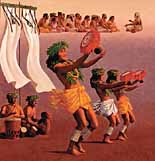
Hawaiian History
& Culture
Hawaiian
Tiki Gods
Hawaiian Culture & Society
Kapu System and Caste System
of Ancient Hawai'i
Polynesian
Caste system
Tribal
Polynesian culture and society evolved into rigid castes in ancient Hawaii. Ancient
Hawaiians were born into specific social classes and did not have the
ability to move into another, except in the case of falling into outcast
status. Each Hawaiian class had assigned duties and responsibilities to
the greater Hawaiian society. These Polynesian Hawaiian classes were more
severe then the tribal Polynesians where some movement was allowed, such as a commoner becoming a priest.

Ancient Hawaiian Culture
Hawaiian
Dancers, Drummers
and a Kahuna Teaching
The Ancient Hawaiian Classes (in order of social status)
Alii, the Hawaiian royal class.
This class
consisted of the high and lesser chiefs of the realms. They governed with
divine power called mana and had the right to wear certain feathers and
protective capes. The Alii's were a driving force behind the frequent warring throughout the Hawaiian islands as they contrived to extend their domains. Commeners were often required to postrate themselves in their presents.
Kahuna, the Hawaiian
priestly class.
This class consisted of the priesthood that tended the temples and conducted
religious activities in the villages. Kahuna's possed the ability (along with Aliis) to place a kapu on places and things, forbidding commoners. Scientists and exceptional navigators
also were deemed to have kahuna status. Akamia advisors would be considered
Kahunas. A kahuna nui was a high priest.
Maka'ainana, the Hawaiian
commoner class.
This class consisted of the farmers, fishermen, bird catchers, weapons
makers, craftsmen and their families. In a feudal Polynesian society,
they were charged with laboring for the overall economy.
Ancient Hawaiian economy became complex over time. People began to specialize in specific skills. Generations of Hawaiian families became committed to certain careers: roof thatchers, house builders (tiki huts!), stone grinders, weapons makers, bird catchers who would make the feather cloaks of the ali'i, and canoe builders. Soon, entire islands began to specialize in certain skilled trades. Oahu became the chief kapa (tapa bark cloth) manufacturer. Maui became the chief canoe manufacturer. The island of ancient Hawaii exchanged bales of dried fish and had contact throughout Polynesia.
Kauwa, the Hawaiian outcast or slave class. This class consisted primarily of people who were considered to be of low birth and thus born without mana. They were not allowed to move up in the caste system or improve their conditions. The mingling of members from other caste groups with the Kauwa was strictly prohibited by kapu. This caste also included prisoners captured in times of war. These prisoners forced to serve the ali'i or were more often used for sacrifice at the luakini heiau. Crushing of bones with club weapons or strangulation was common.
The ancient Hawaiian caste fueled a feudal system relative to feudal systems found in Europe circa A.D. 1000. Ali'i gave lesser ali'i parcels of land who would in turn govern over them. The lesser ali'i divided the land into plots to be farmed and cultivated by maka'ainana families. Harvests were returned to the lesser ali'i, each taking a portion before being sent to the supreme ali'i.
Polynesian
Tribal Hawaii
Feudalism is generally the system in place before evolvement into a nation
state. Ancient Hawaii has often been called tribal. This is probably a
misnomer. The state of Hawaiian organization when Capt. James Cook arrived
had developed past tribalism, imagine a system of slaves (kauwa), peasants
(maka'ainana), knights (kao warriors), priests (kahuna), Dukes (lesser
alii) and kings (alii) in a Polynesian setting. However, the term "Polynesian
tribal Hawaii" could be applied to an earlier time before chaste
systems and economic specialization had occurred. I would consider this
to be the state of affairs during the time of Polynesian expansion and
settlement in Hawaii. Think of the ancient "barbarian" tribes
of Europe before the fall of the Ancient Roman empire. (Northern Europe
c.200 B.c. to c.900 A.D.).
Kapu System - "Akamai polynesia tiki kahuna taboos"
Religion held ancient tribal Polynesian societies together, in Hawaii
it affecting habits, lifestyles, work methods, social policy and law.
The ancient Hawaiian legal system was based on religious kapu, or taboos.
There was a correct way to live, to worship, hold weapons, to eat, even
to make love. Examples of taboos included the provision that men and women
could not eat together. Fishing was limited to specified seasons of the
year. The shadow of the ali'i must not be touched as it was stealing his
mana. Violating taboos even by accident was punishable by death.
Kapu (taboos) was derived from ancestral, ancient Polynesian traditions and beliefs from Hawaiian worship of tiki gods, demigods and ancestral mana.
Akamai
Akamai is a Hawaiian word meaning clever or intelligent, plus some. However
it doesn’t pertain to book smarts, it is more of an understanding
of the mind. It means much more to be akamai, akamai is to be in touch
with the kahuna and taboos. In Polynesia there is a saying, “many
are smart, few are akamai.”